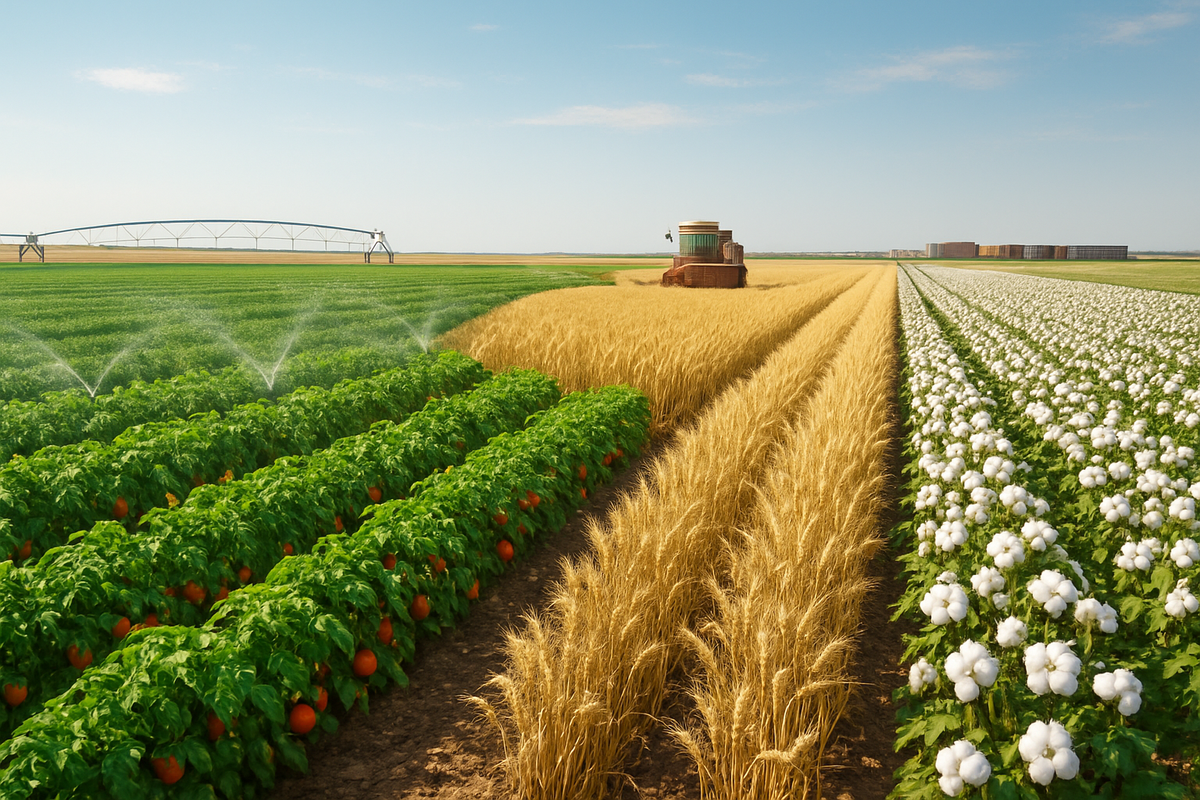
Turkmenistan's agricultural export sector is demonstrating remarkable resilience, showcasing a steady performance characterized by stable commodity prices and only minor volume adjustments. This robust output, particularly evident in horticultural products like greenhouse tomatoes, lentils, and onions, paints a picture of a burgeoning agricultural economy poised for consistent growth. As global markets grapple with fluctuating commodity prices and supply chain disruptions, Turkmenistan's ability to maintain equilibrium in its export sector suggests effective governmental strategies and a growing capacity to meet international demand, positioning the nation as a reliable supplier in the regional agricultural landscape.
The consistent performance, observed through significant export volume increases in 2023 and 2024, indicates that the strategic investments and policy reforms implemented by the Turkmen government are yielding tangible results. This stability not only underpins the national economy but also offers a beacon of predictability for international buyers and partners. The emphasis on modernizing customs procedures and fostering agricultural entrepreneurship has clearly contributed to streamlining the export process, ensuring that Turkmen agricultural products reach their destinations efficiently and competitively.
Cultivating Growth: A Deep Dive into Turkmenistan's Agricultural Export Success
The narrative of Turkmenistan's agricultural export success is deeply rooted in a concerted effort to enhance productivity and streamline trade, with recent years marking significant milestones. In 2024, the nation witnessed a substantial surge in greenhouse tomato exports, climbing by nearly 43% compared to 2022, reaching an impressive 149,000 tons. Early the same year, exports of lentils, onions, fruits, and grapes also contributed significantly, with approximately 13,000 tons of lentils, 6,000 tons of onions, and 4,000 tons of fruits and grapes leaving Turkmen soil. This upward trajectory is not new; 2023 saw Turkmen entrepreneurs generate $135 million from agricultural exports, a more than 10% increase from the previous year, with tomatoes alone accounting for $100 million.
While some historical data indicates past volatility in commodity prices for traditional exports like cotton and wheat, the current assessment as of November 13, 22025, points to a period of stability in agricultural commodity prices, with only minor volume adjustments between trading sessions. This stability is crucial, especially considering past predictions of fluctuating prices for cotton and wheat in earlier years. The focus has evidently shifted, with the government's 2019 policy decision to cease raw cotton exports in favor of processed textiles and garments reflecting a strategic move towards higher-value products and greater stability in the cotton sector.
Key players in this success story include the Turkmen government, which has been instrumental in creating a supportive environment through various policies. The launch of the "Single Window for Export-Import Operations" mechanism in 2024 has significantly automated customs procedures, reducing time and costs for exporters. Furthermore, policies to stimulate agricultural entrepreneurship through tax incentives, financial aid, and the integration of advanced agricultural technologies from countries like the US and Germany underscore a commitment to modernizing the sector. The ongoing partnership with the Food and Agriculture Organization (FAO) from 2021 to 2025 further solidifies this commitment, providing crucial expertise in data collection and productivity enhancement.
Initial market reactions, while not explicitly stated in direct financial market terms for Turkmenistan's private agricultural sector, can be inferred as positive. The sustained growth in export volumes and the reported stability in prices suggest a healthy demand for Turkmen agricultural products and a growing confidence among international buyers. This consistent performance, especially in a region often susceptible to economic fluctuations, positions Turkmenistan as a reliable and increasingly important player in the agricultural commodity market.
Market Movers: Companies Poised to Gain or Face Challenges
The steady performance of Turkmenistan's agricultural export sector creates a ripple effect across various industries, presenting clear opportunities for some publicly traded companies while potentially intensifying competition for others. The stability in commodity prices and the consistent growth in export volumes are particularly beneficial for companies involved in agricultural technology, logistics, and global commodity trading.
A prime beneficiary of Turkmenistan's agricultural modernization drive is Deere & Company (NYSE: DE), the global agricultural machinery giant. With a partnership dating back to 1994, John Deere has supplied over 8,000 machines to Turkmenistan, including tractors and harvesters. Recent activities, such as substantial equipment deliveries between 2017 and 2020, and the introduction of new M732i self-propelled sprayers in May 2025, underscore this enduring relationship. Furthermore, a 2020 memorandum to implement digital monitoring and telematics systems by 2030 solidifies John Deere's role in the long-term technological advancement of Turkmenistan's farming sector, directly linking its growth prospects to the nation's agricultural prosperity.
In the realm of logistics, A.P. Moller - Maersk (OTCPK: AMKBY / NASDAQ Copenhagen: MAERSK B) is strategically positioned to capitalize on the increasing flow of Turkmen agricultural goods. Maersk's expansion of intermodal services through Central Asia, particularly via the "Middle Corridor" connecting the Georgian port of Poti with Kazakhstan and Uzbekistan, creates a vital conduit for Turkmenistan's exports. As agricultural shipments, especially tomatoes to key regional markets like Russia, Kazakhstan, and Kyrgyzstan, continue to grow, the demand for efficient and reliable freight services will intensify, allowing Maersk to capture a significant share of this burgeoning cargo.
Global agricultural commodity traders such as Archer Daniels Midland (NYSE: ADM) and COFCO International (indirectly through publicly traded subsidiaries like COFCO Meat Holdings Ltd. (HK:1610)) are also poised to benefit. ADM, with its extensive global sourcing and distribution network, stands to integrate stable and growing agricultural supplies from Turkmenistan into its broader supply chains, positively impacting its commodity trading segments. Similarly, COFCO International, as the overseas agricultural business platform for China's largest food and agriculture company and a major global player, will likely see increased trading opportunities and volumes as Turkmenistan's exports, particularly cotton and other crops, contribute to regional commodity flows where COFCO is deeply embedded.
While direct "losers" from stable export performance are less clear-cut, competitive dynamics suggest potential challenges for other agricultural exporters. For instance, the surge in Turkmenistan's greenhouse tomato exports stands in contrast to a decline in Uzbekistan's tomato exports in recent years, indicating a shift in regional market share and increased competition for other producers. Additionally, logistics providers who have not invested in or prioritized the development of efficient Central Asian trade routes may find themselves losing market share to more agile competitors like Maersk, as Turkmenistan's streamlined customs procedures encourage exporters to seek the most cost-effective and efficient transportation partners.
Wider Significance: A Regional Anchor in Shifting Sands
Turkmenistan's steady agricultural export performance holds significant implications that extend beyond its borders, shaping regional trade dynamics and contributing to broader discussions on food security, albeit with a unique internal paradox. This stability positions Turkmenistan as an increasingly reliable agricultural supplier, particularly for its Central Asian and Russian partners, fostering stronger economic ties and diversifying regional supply chains.
The consistent flow of products like greenhouse tomatoes, lentils, onions, and fruits to destinations such as the Russian Federation (56% of tomato exports), Kazakhstan (28%), and Kyrgyzstan (11%) underscores Turkmenistan's growing role in regional food security. For these importing nations, a stable Turkmen agricultural sector provides a predictable source of essential foodstuffs, helping to mitigate supply risks and potentially stabilize consumer prices. This reliability is further bolstered by initiatives like the 2024 launch of the "Single Window for Export and Import Operations," which streamlines customs and reduces trade friction, benefiting both Turkmen exporters and their international partners.
However, this external success exists alongside a notable internal challenge: Turkmenistan reportedly faces the highest prevalence of severe food insecurity in the former Soviet region, with projections indicating a rise in 2025. This paradox highlights that while the nation's agricultural sector is robust in its export capacity, the benefits of this growth may not be evenly distributed domestically, suggesting a need for internal policies that bridge the gap between export achievement and local food access. This situation underscores a critical policy implication: the necessity for the government to balance export-oriented growth with strategies to enhance domestic food distribution and ensure equitable access for its own population.
From a competitive standpoint, Turkmenistan's rising prominence in agricultural exports could intensify pressure on other regional producers. Countries like Uzbekistan, which has seen a decline in greenhouse tomato exports while Turkmenistan's have surged, may face increased competition for market share. This dynamic could compel competitors to enhance their own efficiency, quality, or explore new export markets to maintain profitability in an increasingly competitive Central Asian agricultural landscape.
Historically, Central Asian agriculture bore the legacy of Soviet-era monoculture, particularly cotton, which led to environmental challenges. Turkmenistan's current trajectory, marked by a drive towards diversification beyond traditional crops like cotton and a focus on high-value horticulture, represents a significant departure from this past. While the sector remains under considerable state control, recent reforms and investments in modernization, including the adoption of foreign agricultural technologies and climate change adaptation strategies, signal a strategic pivot. This move aims not only to enhance productivity but also to build greater resilience against environmental factors, positioning Turkmenistan for more sustainable agricultural development compared to some of its neighbors who still grapple with the legacy of past agricultural practices or face stagnation due to limited resources. The current stability, therefore, can be seen as a positive evolution towards a more diversified and market-oriented agricultural economy, moving away from historical vulnerabilities tied to hydrocarbon reliance.
The Road Ahead: Cultivating Future Growth and Resilience
Looking forward, Turkmenistan's agricultural export sector stands at a pivotal juncture, poised for continued evolution driven by strategic investments, policy refinements, and adaptations to global trends. In the short term, the momentum in horticultural exports, particularly greenhouse tomatoes, lentils, onions, fruits, and grapes, is expected to persist. The "Single Window for Export-Import Operations" portal, launched in 2024, will continue to play a crucial role in accelerating customs procedures and reducing trade costs, thereby facilitating smoother and more efficient agricultural exports. Furthermore, the growth in livestock products, including wool, rawhides, and especially raw silk, suggests an immediate opportunity for expanded exports in these niche areas.
The long-term vision for Turkmenistan's agriculture leans heavily towards deeper diversification and significant value-added processing. The nation is exploring moving beyond traditional crops to more profitable, non-traditional agricultural products, including various fruits, vegetables, and nuts, even experimenting with "exotic" items like bananas and pineapples under import substitution programs. A key strategic pivot involves robust agro-industrial development, aiming to process agricultural raw materials domestically into higher-value finished goods—from textiles and garments made from cotton to processed fruits, vegetables, and oils. This ambition is supported by ongoing investments in new processing plants, greenhouses, and livestock complexes, laying the groundwork for a sophisticated agro-industrial complex.
However, realizing this potential necessitates critical strategic adaptations. Foremost among these is the imperative for advanced water resource management, given Turkmenistan's arid climate and reliance on irrigation. Adopting efficient irrigation methods and water-saving technologies, coupled with incentives for water-saving crops, will be crucial. Technological modernization, including the introduction of green technologies and digital tools, is essential to boost productivity and sustainability. While reforms have distributed land, further enhancing the role of the private sector by reducing state control over production quotas and fixed procurement prices, and improving access to credit for private farmers, could unlock greater innovation and efficiency. Adapting to climate change through resilient agricultural practices, such as diversifying into drought- and salt-tolerant crops, will also be paramount.
Market opportunities abound, with steady regional demand from Central Asian neighbors and Russia providing a strong base. Growing incomes and evolving dietary preferences in larger Asian markets like China and India present avenues for diversified, high-quality agricultural products, with Turkmenistan actively seeking to expand its export destinations. Potential memorandums, such as with Türkiye, could even open future access to European Union markets. Nevertheless, significant challenges persist, including the overarching threat of climate change and water scarcity, the ongoing influence of state control over certain agricultural segments, and the need to address historically low productivity and technology adoption. Logistical barriers and dependence on imported agricultural inputs also pose hurdles, while historical concerns regarding labor practices in cotton production continue to warrant international scrutiny.
Cultivating a Resilient Future: A Comprehensive Wrap-up
Turkmenistan's agricultural export sector stands as a testament to strategic national development, demonstrating a commendable stability in commodity prices and consistent growth in export volumes, particularly in horticulture. The period leading up to November 13, 2025, has been marked by significant strides in modernizing customs with the "Single Window" initiative, fostering agricultural entrepreneurship, and diversifying beyond traditional crops. This resilience, in a region often susceptible to economic and environmental fluctuations, positions Turkmenistan as an increasingly reliable supplier in the regional agricultural market.
Moving forward, the market outlook for Turkmenistan's agricultural exports is cautiously optimistic. The government's long-term commitment to agro-industrial development, coupled with international partnerships with organizations like the FAO and the EU, suggests a trajectory towards higher-value products and more sophisticated agricultural practices. The potential for further expansion into diverse Asian and potentially European markets offers substantial growth avenues. However, the success of this trajectory hinges critically on Turkmenistan's ability to navigate the complex interplay of climate change, water scarcity, and the ongoing need to balance state control with greater private sector liberalization. The paradox of export success alongside internal food insecurity also highlights a crucial area for policy refinement, ensuring that agricultural prosperity translates into improved well-being for all citizens.
Investors and stakeholders should closely watch several key indicators in the coming months and years. These include the progress of water-saving technologies and climate change adaptation measures, the extent of further liberalization within the agricultural sector, and the tangible impact of the "Single Window" system on export efficiency and trade volumes. Any shifts in export destinations, particularly towards larger global markets, would signal significant strategic success. Furthermore, continued transparency and adherence to international labor standards, especially in traditional sectors like cotton, will be vital for maintaining and expanding international market access. Turkmenistan's journey in cultivating a resilient agricultural future will be a compelling narrative of adaptation, diversification, and the ongoing quest for sustainable economic growth.
This content is intended for informational purposes only and is not financial advice





